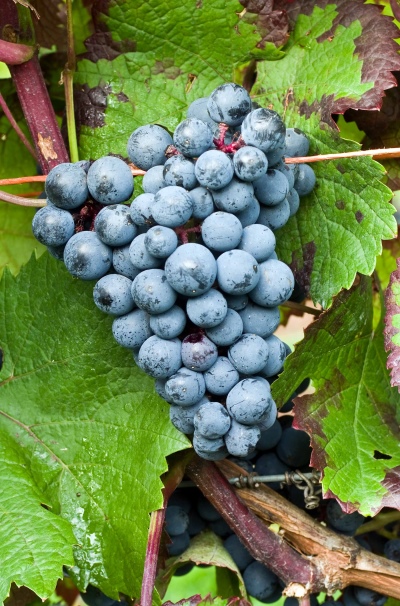
- Authors: IViV them. V.E. Tairova, Ukraine
- Appointment: technical
- Berry color: black
- Taste: simple
- With bones: Yes
- Ripening period: early
- Ripening period, days: 130
- Frost resistance, ° C: -26
- Bunch weight, g: 100-120
- Yield: 114 c / ha
Among the technical grape varieties, gardeners have their favorites and favorites. In this article, we will consider technical grapes of the Golubok variety. We will indicate the features of this species, its frost resistance, yield and taste.
Breeding history
The Golubok grape belongs to complex hybrids. It was received in 1958 at the Ukrainian Institute of Viticulture and Winemaking. V.E. Tairova. For creation, 4 different species were taken, which were pollinated among themselves. The parents of this variety are the grapes Northern, Odessa early, 40 years of October and No. 1-17-54. It should be noted that the variety No. 1-17-54 is also a hybrid derived from the crossing of Cabernet Sauvignon and Alikat Boucher.
All the work was carried out by Russian and Ukrainian breeders. And in 1981, the variety was introduced to the market. To this day, grapes do not lose their popularity, although most often they can be found on the territory of Ukraine.
Description
In terms of ripening, the dove belongs to the early varieties. His bushes are medium-sized, short. The vine is strong, massive, and the trunk diameter is 10 cm. The leaves are medium, deep green in color, have three lobes with jagged edges at the end. Rounded at the edges, have a light pile on the back. Flowering is accompanied by a strong aroma, the flowers are small.
Ripening period
As noted earlier, this culture is early maturing. Flowering begins in May, and the ripening period itself takes 130 days. The grapes are grown for different types of wines. If the variety is grown for table wine, then the harvest is harvested in September, and for strong or dessert wines, the harvest takes place in October.
Bunches
The clusters are medium, they are up to 17 cm long and 10 cm wide. Their shape is cylindrical-conical, but there are also simply conical brushes. The brush leg is short, up to 4 cm.Bunches are small by weight - only 100-120 g.
Berries
The berries have a deep black hue, they are round and medium in size. The average weight does not exceed 2 g, and the size is 15 mm. The rind is thin and firm, with a glossy and dense waxy coating. The pulp is juicy, fleshy. Because of the skin, the juice is strongly colored.
Taste
The berries are pleasant to the taste, have a slightly tart aftertaste, somewhat reminiscent of currants. The sugar content is 23 g / dm3, and the acidity is 6-8 g. Therefore, this variety is usually used for homemade juices or wines.
Yield
The yield of this hybrid is very high - 114 kg / ha. Shoots ripen 80-93%.


Growing features
The Golubok grape loves moisture, so dry areas are not suitable for it. Indeed, due to drought, the percentage of juice content in berries falls, they wrinkle and lose their attractiveness. The bushes should be fed several times per season. This will have a beneficial effect on growth and yield.
Do not overload the bushes too much. They need to be formed and removed every year, otherwise the berries will begin to shrink.Grapes also prefer loose soil, so loosen the soil around the trunk once a week.
Landing
The soil must be chosen moist, which retains moisture for a long time. If the site is dry, then before planting it is worth taking care of drip irrigation.
When planting bushes, we form pits. The distance between the seedlings is 1.5-2 m, and between the rows - 2-3 m. We spread fertilizer on the bottom (humus or manure is suitable), then we cover it with earth with a small hill. A seedling falls on this hill. Next, the bush is sprinkled with earth and tamped. Sprinkle abundantly with water. It is worth watering the seedlings as soon as the ground has become practically dry. But no more than 2-3 times a week. In a rainy period, you should not additionally water the bushes.

Pollination
This hybrid has bisexual flowers, so no additional pollination is required.
Pruning
With annual pruning, it is worth remembering that this variety can withstand a load of 45 eyes. If you leave more eyes, then not all berries will ripen. It is also worth doing annual pruning after winter, removing damaged branches or those that are frozen. During the season, it is worth thinning out dry shoots and specimens that have begun to break out of the bush. It is also worth pruning overly creeping shoots.



Frost resistance and the need for shelter
The plant is frost-resistant, but it still needs to be covered, because grapes are thermophilic. Covering should be chosen dense. It is necessary to cover the bush completely.

Diseases and pests
Dove grapes rarely suffer from fungal diseases, such as mildew, gray rot. But it is still necessary to carry out preventive spraying once a season.
The main pests are bees and wasps, which love to feast on fresh ripe berries.

If a grape is exposed to any disease or insect, this always affects its appearance.
Storage
The shelf life is high - up to 1-2 months. The room must be dry and with a humidity of no more than 70%.











































































